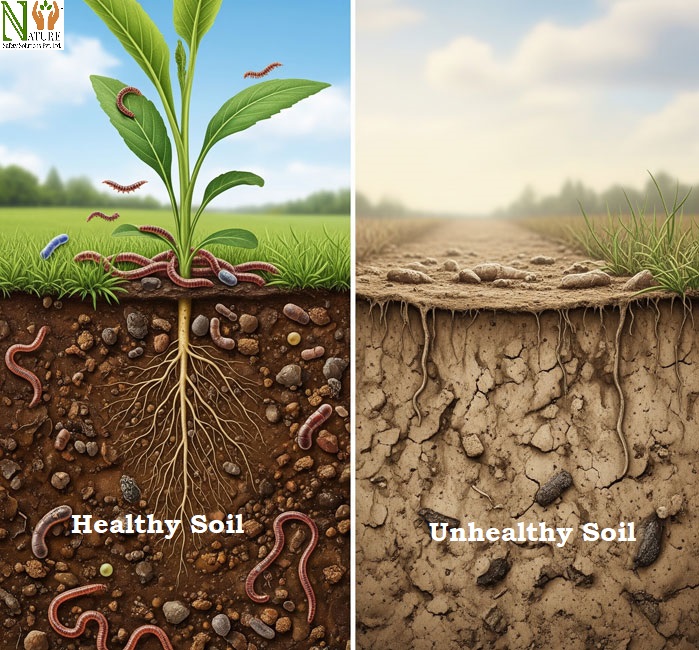The ground beneath our feet is more than just dirt—it’s the foundation of all life on Earth. Healthy soil supports our food supply, filters water, stores carbon, and sustains ecosystems.
Yet, soil is under constant threat from pollution, industrial activities, poor agricultural practices, and climate change. For businesses and industries, protecting soil isn’t just an environmental responsibility—it’s a core part of Environment, Safety, and Health (ESH) strategies.
In this article, we’ll explore why soil health is vital, how industrial activities affect it, and the ESH strategies needed to protect and sustain this precious resource.

Why Soil Health Matters
Soil is a living ecosystem teeming with microorganisms, minerals, and organic matter. It plays a critical role in:
- Food production: Over 95% of our food comes from the soil.
- Water filtration: Healthy soil acts as a natural filter, removing pollutants before they reach groundwater.
- Climate regulation: Soil stores carbon and reduces greenhouse gases.
- Ecosystem stability: Plants, animals, and humans depend on healthy soil for survival.
When soil quality declines, it leads to reduced crop yields, water contamination, and loss of biodiversity—impacting both the environment and human health.
Industrial Impact on Soil
Industries often contribute to soil degradation and contamination. Some common threats include:
- Chemical spills and leaks: Factories, refineries, and warehouses can release hazardous substances into the ground.
- Improper waste disposal: Dumping of industrial waste leads to long-term contamination.
- Construction and mining: These activities strip topsoil, reduce fertility, and disrupt natural habitats.
- Excessive pesticide use: Harmful chemicals not only affect crops but also seep into soil layers, damaging microorganisms.
Such issues make it essential for organizations to adopt soil protection measures within their ESH programs.
ESH Strategies for Soil Protection
1. Pollution Prevention
The first step is to stop contamination before it starts. Industries must ensure safe handling of chemicals, use spill prevention equipment, and adopt eco-friendly materials wherever possible.
2. Soil Testing and Monitoring
Regular soil testing helps identify contamination early. Monitoring pH levels, nutrient content, and toxins enables companies to take corrective actions before irreversible damage occurs.
3. Proper Waste Management
Recycling, safe disposal of hazardous waste, and compliance with regulatory standards like EPA guidelines and ISO 14001 are crucial for soil safety.
4. Sustainable Land Use
Construction and agricultural activities should prioritize minimal disruption to natural soil layers. Techniques like crop rotation, organic farming, and afforestation help maintain long-term soil health.
5. Training and Awareness
Employees must be trained in ESH practices, including safe chemical storage, emergency response for spills, and best practices for waste handling.
The Link Between Soil and Safety
Soil contamination isn’t just an environmental issue—it’s a human health risk. Toxic chemicals in the ground can leach into drinking water or enter the food chain. Heavy metals like lead and mercury can cause neurological damage, while pesticides and industrial chemicals are linked to respiratory and reproductive problems.
By integrating soil safety into workplace ESH plans, companies can protect not only the environment but also the well-being of workers and surrounding communities.
Moving Toward Sustainability
Soil protection is not just about preventing harm—it’s about building a sustainable future. Companies that invest in soil health demonstrate corporate responsibility and often see long-term benefits, such as improved public trust, compliance with regulations, and reduced environmental liabilities.
Adopting sustainable practices like green infrastructure, bioremediation, and soil restoration projects ensures that soil can continue to support life for generations to come.
Also read:-
- The Hidden Impact of Food Waste on Our Environment
- How Everyday Choices at Home Impact the Planet
- Understanding EHS Audits: A Comprehensive Guide to Workplace Safety and Environmental Responsibility
- Microplastics in Everything: A Silent Global Threat
- The Power of Youth Activism in Environmental Change
